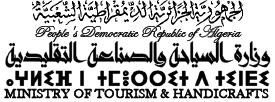The traditional jewelry is a brilliantly designed silver jewelry that reflects the simple life of the tribes, and one of its peculiarities is the presence of enamel of different colors (blue, green, yellow) with a bright red coral in the middle This finely carved silver jewelry, with enamel markings, reinforced with coral stones rooted in Beni Yenni, is widely distributed in many municipalities of Tizi Ouzou province. Despite the modernization of the traditional jewelry industry, it maintains its traditional touch.


Pottery is one of the ancient arts, formed and made mainly by hand using clay, brushes, wooden squeaks and smoothing stones. The manufacturing process goes through five main stages: ground preparation and shaping, glazing, decorating, cooking and polishing. The most important production centers are located in Maataqa, Ait Khair and Ain al-Zawiya.


The carpet is made of wool and multicolored. It can be of daily use, used on the floor or on the walls. According to the customs and traditions, the women of the Kabylia region allocate their own carpet for each event with its own geometric shapes that differ from one region to another and from one village to another. Our Wilayat is rich in several types of carpets, including: the Ait Hisham carpet, the Beni Zamanzer carpet, and the Wade carpet.


Kabyle dress has always been a subject of creativity and consists of five elements: the Kabyle robe, called “Thakandorth” is the main element of the costume, reinforced by a towel, called “foudha” decorated with multicolored vertical stripes. The belt, called “h’zam”, consists of a set of multicolored woolen threads braided and fitted. The headdress consisted of a square scarf, called a ‘m’harma’, decorated and folded into a triangle at the neck before being tied to the fringes above the forehead.
The tribal dress is witnessing an openness to the world, which inspires the craftsmen to be creative. And it became lighter, finer and thinner models. The most important areas that are famous for sewing traditional dress are: Wadia, Bouzeguen, Azazka, Beni Douala and Maataka.


Embroidery on the fabric with symmetrical and symmetrical Kabyle geometric shapes attracts the attention and the most important areas known for this craft are the municipality of Arba’ Naith Irathan.


The wood industry is closely related to agricultural activity. However, it is also intended for home use, especially doors and various dishes. With regard to engraving on wood, it is used for decoration and requires concentration and imagination to create precise geometric shapes. This activity is centered in the Jumaa Saharij area in Maqla and Tizi Rashed, and the area of Ifrahounan and Iliten is famous for making couscous dishes, spoons and rooms.


It is the art of plaiting plant fibers and depends on plants found in nature such as raffia, reeds and bamboo and requires great skill, and weaves gabions, baskets and utilitarian products. And the main production pillars are the villages of Ain Mzyab in Batrouna – Tizi – Ouzou and Jumaa Saharij – Meklaa.




